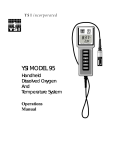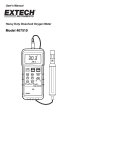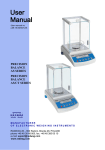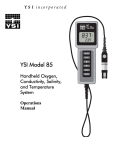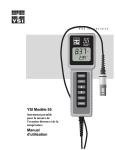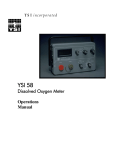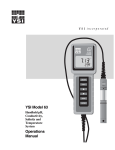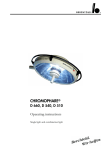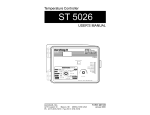Download YSI Model 55 Operations Manual
Transcript
YSI Model 55 Handheld Dissolved Oxygen and Temperature System Operations Manual Table of Contents 1. General Description ......................................................................................................1 2. Specifications ................................................................................................................2 3. Preparing The Meter .....................................................................................................3 3.1. Unpacking.........................................................................................................................3 3.2. Warranty Card ..................................................................................................................3 3.3. Batteries ............................................................................................................................3 3.4. Calibration/Storage Chamber...........................................................................................4 3.5. Hand Strap ........................................................................................................................4 3.6. The Meter Case.................................................................................................................4 4. Preparing The Probe.....................................................................................................5 4.1. Description........................................................................................................................5 4.2. Choosing The Right Membrane.......................................................................................5 4.3. Probe Preparation..............................................................................................................5 4.4. Membrane Installation......................................................................................................6 4.5. Probe Operation and Precautions.....................................................................................7 5. Calibration......................................................................................................................8 5.1. Before You Calibrate........................................................................................................8 5.2. The Calibration Process....................................................................................................8 6. Principles Of Operation................................................................................................10 6.1. Discussion Of Measurement Errors.................................................................................10 7. Troubleshooting............................................................................................................12 8. Warranty And Repair ....................................................................................................14 8.1. Cleaning Instructions........................................................................................................15 8.2. Packing Instructions .........................................................................................................16 9. Required Notice.............................................................................................................17 10. Accessories And Replacement Parts .......................................................................18 11. Appendix A - Solubility Table ....................................................................................19 12. Appendix B - Conversion Chart ................................................................................21 i 1. General Description The YSI Model 55 Handheld Dissolved Oxygen System is a rugged, micro-processor based, digital meter with an attached YSI dissolved oxygen probe. The YSI Model 55 is designed for field use and is available with cable lengths of 12, 25 or 50 feet. The body of the probe has been manufactured with stainless steel to add rugged durability and sinking weight. The large Liquid Crystal Display (LCD) is easy to read and is equipped with a backlight for use in dark or poorly lighted areas. The Model 55's micro-processor allows the system to be easily calibrated with the press of a few keys. Additionally, the micro-processor performs a self-diagnostic routine each time the instrument is turned on. The self-diagnostic routine provides you with useful information about the function of the instrument circuitry and the quality of the readings you obtain. For a list of these diagnostic features, see chapter 7 Troubleshooting. The system simultaneously displays temperature in oC and dissolved oxygen in either mg/L (milligrams per liter) or % air saturation. The system requires only a single calibration regardless of which dissolved oxygen display you use. You can switch back and forth from % air saturation to mg/L with a single push of the MODE key. A calibration chamber is built into the instrument. A small sponge in the chamber can be moistened to provide a water saturated air environment which is ideal for air calibration. This chamber is also designed for transporting and storing the probe. When the probe is stored in the chamber, the moist environment will prolong effective membrane performance and probe life. The instrument is powered by six AA-size alkaline batteries. A new set of alkaline batteries will provide approximately 100 hours of continuous operation. When batteries need to be replaced, the LCD will display a "LO BAT" message. The YSI Model 55 instrument case is splash resistant. You can operate your Model 55 in a steady rain without damage to the instrument. 1 2. Specifications Probe Operating Environment Medium: fresh, sea, or polluted water Temperature: -5 to +45oC Depth: 0 to 12, 0 to 25 or 0 to 50 feet (depending on cable length) Meter Ambient Operating/Storage Temperature: -10 to +50oC Material: ABS, Stainless Steel, Acrylic, and other materials. Dimensions: Height: 9.5 inches (24.13 cm) Thickness: 2.2 inches (5.6 cm) Width: 3.5 inches max. ( 8.89 cm) Weight: 1.7 pounds ( 0.77 kg) Power: 9 VDC - 6 AA-size Alkaline Batteries (included) Approximately 100 hours operation from each new set of batteries Water Tightness: Meets or exceeds IP65 standards Extensive testing of the YSI Model 55 suggests the following typical performance: Temperature Sensor Type................Thermistor Range..........................-5 to +45oC Accuracy ....................± 0.2oC Resolution ..................0.1oC Dissolved Oxygen % Saturation Sensor Type................Membrane covered polarographic Range..........................0 to 200 % air saturation Accuracy ....................± 2 % air saturation Resolution ..................0.1 % air saturation Dissolved Oxygen mg/L Sensor Type................Calculated from % air saturation, temperature and salinity. Range..........................0 to 20 mg/L Accuracy ....................± 0.3 mg/L Resolution ..................0.01 mg/L 2 3. Preparing The Meter 3.1. Unpacking When you unpack your new YSI Model 55 Handheld Dissolved Oxygen System for the first time, check the packing list to make sure you have received everything you should have. If there is anything missing or damaged, call the dealer from whom you purchased the Model 55. If you do not know which of our authorized dealers sold the system to you, call YSI Customer Service at 800-7654974 or 937-767-7241, and we'll be happy to help you. 3.2. Warranty Card Before you do anything else, please complete the Warranty Card and return it to YSI. This will record your purchase of this quality instrument in our computer system. Once your purchase is recorded, you will receive prompt, efficient service in the event any part of your YSI Model 55 should ever need repair. 3.3. Batteries There are a few things you must do to prepare your YSI Model 55 for use. First, locate the six AA-size alkaline batteries which were included. Use a screwdriver or a small coin to remove the thumbscrew on the bottom of the instrument. This thumbscrew holds the batterychamber cover in place. The battery-chamber cover is marked with the words "OPEN" and "CLOSE." O-RING HAND STRAP POLARITY LABEL NOTE: On some models, the battery cover thumbscrew may be unscrewed by hand (a screwdriver may not be required). BATTERY CHAMBER LID There is a small label inside each of the two battery-chamber sleeves. These labels illustrate the correct way to install the batteries into each sleeve of the battery-chamber. NOTE: It is very important that the batteries be installed ONLY as illustrated. The instrument will not function if the batteries are installed incorrectly. 3 Turn the instrument on by pressing and releasing the ON/OFF button on the front of the instrument. The instrument will activate all segments of the display for a few seconds, which will be followed by a self test procedure which will last for several more seconds. During this power on self test sequence, the instrument’s microprocessor is verifying that the instrument is working. If the instrument were to detect a problem, a continuous error message would be displayed. If the instrument does not operate, consult chapter 7 Troubleshooting. NOTE: The information on the display will be meaningless since the probe has not yet been prepared. You may also want to take the instrument into a dark room and, with the instrument ON, hold down the LIGHT key. The instrument back-light should illuminate the LCD so that the display can be easily read. 3.4. Calibration/Storage Chamber The Model 55 has a convenient calibration/storage chamber built into the instrument’s side. This chamber provides an ideal storage area for the probe during transport and extended non-use. If you look into the chamber, you should notice a small round sponge in the bottom. Carefully put 3 to 6 drops of clean water into the sponge. Turn the instrument over and allow any excess water to drain out of the chamber. The wet sponge creates a 100% water saturated air environment for the probe which is ideal for dissolved oxygen calibration. CALIBRATION CHAMBER 3.5. Hand Strap The hand strap is designed to allow comfortable operation of the Model 55 with minimum effort. If the hand strap is adjusted correctly, it is unlikely that the instrument will be easily dropped or bumped from your hand. To adjust the hand strap on the back of the meter, unsnap the leather cover and pull the two Velcro strips apart. Place your hand between the meter and the strap and adjust the strap length so that your hand is snugly held in place. Press the two Velcro strips back together and snap the leather cover back into place. 3.6. The Meter Case The meter case is sealed at the factory and is not intended to be opened, except by authorized service technicians. Do not attempt to separate the two halves of the meter case as this may damage the instrument, break the water-proof seal, and may void the manufacturer's warranty. 4 4. Preparing The Probe 4.1. Description The YSI Model 55 dissolved oxygen probe is a nondetachable, polarographic sensor designed specifically for the YSI Model 55 Handheld Dissolved Oxygen System. Probe cables are available in lengths of 12, 25 or 50 feet. 4.2. Choosing The Right Membrane The YSI Model 5775 Standard Membrane Kit is supplied with the YSI Model 55. This kit contains thirty 1 mil (.001") membranes and a bottle of KCl solution. YSI recommends the 5775 membranes for most applications. For special conditions, a 0.5 mil (.0005") membrane is available. Order YSI Model 5776 High Sensitivity Membrane Kit. This half-thickness membrane improves measurement time at low temperatures and helps suppress background current at very low dissolved oxygen levels. When data is routinely collected at sample temperatures below 15oC and at dissolved oxygen levels below 20% air saturation, the low signal current resulting from the use of the standard membranes tends to magnify the probe's inherent constant background signal. Using the high sensitivity membranes in this situation will decrease the percentage of error due to the probe's background current. For long-term monitoring situations ONLY, a half-sensitivity, double-thickness, 2 mil (.002") membrane is available. For these applications, order the YSI Model 5685 Membrane Kit, which includes membranes and electrolyte. 4.3. Probe Preparation The YSI Model 55 probe is shipped dry. Before using the Model 55, the protective membrane on the probe tip must be removed, the probe must be filled with KCl solution and a new membrane must be installed. Follow the instructions below to install the KCl solution and membrane. To prepare for installation of a new membrane on your YSI Model 55 dissolved oxygen probe: 1. Unscrew the probe sensor guard. 2. Remove the old O-ring and membrane. 3. Thoroughly rinse the sensor tip and KCl reservoir with distilled water. 4. Prepare the electrolyte according to the directions on the KCl solution bottle. 5 4.4. Membrane Installation A. Secure a membrane between your thumb and the probe body. Add electrolyte to the probe until a large meniscus completely covers the gold cathode. NOTE: Handle the membrane material with care, touching it at the ends only. A B B. With the thumb and forefinger of your other hand, grasp the free end of the membrane. C. With a continuous motion, stretch the membrane up, over, and down the other side of the sensor. Stretching forms the membrane to the contour of the sensor tip. D. Secure the end of the membrane under your forefinger while continuing to hold the probe. C E. Roll the O-ring over the end of the probe, being careful not to touch the membrane surface. There should be no wrinkles in the membrane or trapped air bubbles under the membrane. Some wrinkles may be removed by lightly tugging on the edges of the membrane beyond the O-ring. F. Trim off excess membrane with scissors or a sharp knife. Check that the stainless steel temperature sensor is not covered by excess membrane. D E G. Shake off excess KCl. Rinse the stainless steel thoroughly with distilled water to prevent corrosion. Reinstall the sensor guard. The sensor should be kept in a humid environment (such as the calibration chamber) between measurements and when not in use. 6 F 4.5. Probe Operation and Precautions 1. Membrane life depends on usage. Membranes will last a long time if installed properly and treated with care. Erratic readings are a result of loose, wrinkled, damaged, or fouled membranes, or from large (more than 1/8" diameter) bubbles in the electrolyte reservoir. If erratic readings or evidence of membrane damage occurs, you should replace the membrane and the KCl solution. The average replacement interval is two to four weeks. 2. If the membrane is coated with oxygen consuming (e.g. bacteria) or oxygen evolving organisms (e.g. algae), erroneous readings may occur. 3. Chlorine, sulfur dioxide, nitric oxide, and nitrous oxide can affect readings by behaving like oxygen at the probe. If you suspect erroneous readings, it may be necessary to determine if these gases are the cause. 4. Avoid any environment which contains substances that may attack the probe materials. Some of these substances are concentrated acids, caustics, and strong solvents. The probe materials that come in contact with the sample include FEP Teflon, acrylic plastic, EPR rubber, stainless steel, epoxy, polyetherimide and the polyurethane cable covering. 5. For correct probe operation, the gold cathode must always be bright. If it is tarnished (which can result from contact with certain gases), or plated with silver (which can result from extended use with a loose or wrinkled membrane), the gold surface must be restored. To restore the cathode, you may either return the instrument to the factory or clean it using the YSI Model 5680 Probe Reconditioning Kit. Never use chemicals or abrasives not supplied with this kit. 6. It is also possible for the silver anode to become contaminated, which will prevent successful calibration. To clean the anode, remove the O-ring and membrane and soak the probe overnight in 3% ammonium hydroxide. Next, rinse the sensor tip and KCl reservoir with deionized water, add new KCl solution, and install a new membrane and O-ring. Turn the instrument on and allow the system to stabilize for at least 30 minutes. If, after several hours, you are still unable to calibrate, return the YSI Model 55 system to an authorized service center for service. 7. If the sensor O-ring is worn or loose, replace it with the appropriate O-ring provided in the YSI Model 5945 O-ring Pack. 8. To keep the electrolyte from drying out, store the probe in the calibration/storage chamber with the wet sponge. 7 5. Calibration Dissolved oxygen calibration must be done in an environment with a known oxygen content. Since the amount of oxygen in the atmosphere is known, it makes an excellent environment for calibration (at 100% relative humidity). The calibration/storage chamber contains a moist sponge to create a 100% water saturated air environment. 5.1. Before You Calibrate Before you calibrate the YSI Model 55, complete the procedures discussed in the Preparing the Meter and Preparing the Probe chapters of this manual. To accurately calibrate the YSI Model 55, you will need to know the following information: • The approximate altitude of the region in which you are located. • The approximate salinity of the water you will be analyzing. Fresh water has a salinity of approximately zero. Sea water has a salinity of approximately 35 parts per thousand (ppt). If you are not certain what the salinity of the sample water is, use a YSI Model 30 SalinityConductivity-Temperature meter to determine it. 5.2. The Calibration Process 1. Ensure that the sponge inside the instrument's calibration chamber is wet. Insert the probe into the calibration chamber. 2. Turn the instrument on by pressing the ON/OFF button on the front of the instrument. Wait for the dissolved oxygen and temperature readings to stabilize (usually 15 minutes is required after turning the instrument on). 3. To enter the calibration menu, use two fingers to press and release both the UP ARROW and DOWN ARROW keys at the same time. 4. The LCD will prompt you to enter the local altitude in hundreds of feet. Use the arrow keys to increase or decrease the altitude. CALIBRATION CHAMBER EXAMPLE: Entering the number 12 here indicates 1200 feet. 8 5. When the proper altitude appears on the LCD, press the ENTER key. The Model 55 should now display CAL in the lower left of the display, the calibration value should be displayed in the lower right of the display and the current DO reading (before calibration) should be on the main display. 6. Make sure that the DO reading (large display) is stable, then press the ENTER button. The LCD will prompt you to enter the approximate salinity of the water you are about to analyze. You can enter any number from 0 to 40 parts per thousand (PPT) of salinity. Use the arrow keys to increase or decrease the salinity setting. When the correct salinity appears on the LCD (zero for fresh water), press the ENTER key. The instrument will return to normal operation. Once the calibration process is complete, the only keys which will remain operational are the MODE key, the LIGHT key and the ON/OFF key. You can move back and forth from reading dissolved oxygen in the mg/L mode or the % air saturation mode by pressing the MODE key. If you are working in a dark area and have difficulty reading the LCD, press and hold the LIGHT key to activate the back-light of the YSI Model 55. The ON/OFF key turns the instrument on or off. For best results: • Each time the Model 55 is turned off, re-calibrate before taking measurements. • Calibrate at a temperature within ±10°C of the sample temperature. 9 6. Principles Of Operation The sensor consists of an acrylic body with a circular gold cathode embedded in the end. Inside the gold ring there is a small chamber containing a porous silver anode. In operation, this chamber is filled with a solution of KCl electrolyte containing a small amount of surfactant to improve wetting action. A thin permeable membrane, stretched over the sensor, isolates the electrodes from the environment, while allowing gases to enter. When a polarizing voltage is applied to the sensor electrodes, oxygen which has passed through the membrane reacts at the cathode causing a current to flow. The membrane passes oxygen at a rate proportional to the pressure difference across it. Since oxygen is rapidly consumed at the cathode, it can be assumed that the oxygen pressure inside the membrane is zero. Hence, the force causing the oxygen to diffuse through the membrane is proportional to the partial pressure of oxygen outside the membrane. As the oxygen partial pressure varies, so does the oxygen diffusion through the membrane. This causes the probe current to change proportionally. It is important to recognize that oxygen dissolved in the sample is consumed during the test. It is therefore essential that the sample be continuously stirred at the sensor tip. If stagnation occurs, your readings will be artificially low. Stirring may be accomplished by mechanically moving the sample around the probe tip, or by rapidly moving the probe through the sample. The rate of stirring should be at least 1 foot per second. 6.1. Discussion Of Measurement Errors There are three basic types of dissolved oxygen errors. Type 1 errors are related to limitations of instrument design and tolerances of instrument components. These are primarily the meter linearity and the resistor tolerances. Type 2 errors are due to basic probe accuracy tolerances, mainly background signal, probe linearity, and variations in membrane temperature coefficient. Type 3 errors are related to the operator's ability to determine the conditions at the time of calibration. If calibration is performed against more accurately known conditions, type 3 errors are appropriately reduced. Type 1 Errors A. Meter linearity error: ±1% of full scale reading, or ±0.15 mg/L B. Component and circuitry error: ±0.05 mg/L Type 2 Errors A. DO errors caused by temperature compensation for measurements at ±10°C from calibration temperature: ±1% (0.08 mg/L at 25°C) DO errors caused by temperature measurement errors: A maximum ±0.2°C temperature error is equal to ±0.5% (0.04mg/L at 25°C). 10 Type 3 Errors A. Altitude: Operator Error: A 1000 foot error in altitude (when calibrating) is equal to an error of approximately 3.6% at the 10 mg/L level. Instrument Error: The maximum DO error caused by calibrating to altitude in increments of 100 feet: ±0.18% (< 0.015 mg/L at 25°C) B. Humidity: Errors occur if calibration is performed at less than 100% humidity. The worst possible case would be calibration at 0% humidity. The error varies with the calibration temperature as follows: Temperature Calibration Error at 0% humidity 0oC 0.09 mg/L 10oC 0.14 mg/L 20oC 0.21 mg/L 30oC 0.33 mg/L 40oC 0.50 mg/L Approximating The Error It is unlikely that the actual error in any measurement will be the maximum possible error. A better error approximation is obtained using a root mean squared (r.m.s.) calculation: r.m.s. error = ±[1a2 + 1b2 + 2a2 + 2b2 + 3a2 + 3b2]½ mg/L NOTE: This sample calculation is for a near extreme set of conditions. 11 7. Troubleshooting NOTE: An error displayed briefly during the first few seconds after turning the instrument on does NOT indicate a problem. SYMPTOM 1. Instrument will not turn on 2. Instrument will not calibrate 3. Instrument "locks up" POSSIBLE CAUSE ACTION A. Low battery voltage A. Replace batteries (Page 3) B. Batteries installed incorrectly B. Check battery polarity. (Page 3) C. Meter requires service C. Return system for service (Page 14) A. Membrane is fouled or damaged A. Replace membrane and KCl (Page 6) B. Probe anode is fouled or dark B. Clean anode (Page 7) C. Probe cathode is tarnished C. Clean cathode (Page 7) D. System requires service D. Return system for service (Page 14) A. Instrument has received a shock B. Batteries are low or damaged A. Remove battery lid, wait 15 seconds for reset, replace lid. (Page 3) C. System requires service B. Replace batteries (Page 3) C. Return system for service (Page 14) 4. Instrument readings are inaccurate A. Cal altitude is incorrect A. Recalibrate w/correct value (Page 8) B. Salinity setting is incorrect B. Recalibrate w/correct value (Page 8) C. Probe not in 100% water saturated air during Cal procedure D. Membrane fouled or damaged C. Moisten sponge and place in Cal chamber w/ probe and Recal (Page 4, 8) E. Probe anode is fouled or dark D. Replace membrane (Page 6) F. Probe cathode is tarnished E. Clean anode (Page 7) G. System requires service F. Clean cathode (Page 7) G. Return system for service (Page 14) 5. LCD displays "LO BAT" A. Batteries are low or damaged A. Replace batteries (Page 3) A. Probe current too low to calibrate A. Replace membrane and KCl (Page 6) or Main display flashes “OFF” 6. Main display reads “undr” B. System requires service B. Clean anode (Page 7) C. Clean cathode (Page 7) D. Return system for service (Page 14) 7. Main display reads “OVEr” A. Sample O2 concentration is more than 20 mg/L A. Recalibrate using correct altitude and salinity compensation (Page 8). B. Probe current too high to calibrate B. Replace membrane and KCl (Page 6) C. System requires service C. Clean cathode (Page 7) D. Clean anode (Page 7) E. Return system for service (Page 14) 8. Main display reads "Er 0" A. Calibration current out of range A. Replace membrane and KCl (Page 6) B. Instrument's self-test detects improper probe voltage during calibration B. Clean anode (Page 7) 12 C. Clean cathode (Page 7) D. Return system for service (Page 14) SYMPTOM 9. Main display reads "Er 1" or Main display reads “Err” (Secondary display reads “ra”) 10. Main display reads "Er 2" or Main display reads “Err” POSSIBLE CAUSE ACTION A. Instrument's self-test detects a variance in RAM A. Remove battery lid, wait 15 seconds for reset, replace lid. (Page 3) B. System requires service B. Return system for service (Page 14) A. Instrument's self-test detects a variance in ROM checksum A. Remove battery lid, wait 15 seconds for reset, replace lid. (Page 3) B. System requires service B. Return system for service (Page 14) A. Instrument's self-test detects a system malfunction or component failure A. Remove battery lid, wait 15 seconds for reset, replace lid. (Page 3) (Secondary display reads “ro”) 11. Main display reads "Er 3" or Main display reads "FAIL" (secondary display reads “eep”) 12. Main display reads "Er 4" B. Return system for service (Page 14) B. System requires service A. Sample O2 concentration is more than 20 mg/L A. Recalibrate using correct altitude and salinity compensation (Page 8). B. System requires service B. Replace membrane and KCl (Page 6) C. Clean anode (Page 7) D. Clean cathode (Page 7) E. Return system for service (Page 14) 13. Main display reads "Er 5" 14. Main display reads "Er 6" A. Displayed O2 concentration is below -0.5 mg/L. A. Recalibrate using correct altitude and salinity compensation (Page 8). B. System requires service B. Return system for service (Page 14) A. Sample O2 concentration is over range (% mode) A. Recalibrate using correct altitude and salinity compensation (Page 8). B. System requires service B. Replace membrane and KCl (Page 6) C. Clean anode (Page 7) D. Clean cathode (Page 7) E. Return system for service (Page 14) 15. Main display reads "Er 7" 16. Secondary display reads "Er 8" or Main Display reads “OVEr” A. Displayed O2 concentration is below -3.0% A. Recalibrate using correct altitude and salinity compensation (Page 8). B. System requires service B. Return system for service (Page 14) A. Sample temperature is more than +45.9oC A. Reduce the sample temperature B. Return system for service (Page 14) B. System requires service (Secondary display reads “ovr”) 17. Secondary display reads "Er 9" or Main Display reads “OVEr” A. Sample temperature is less than o -5 C A. Increase sample temperature. B. Return system for service (Page 14) B. System requires service (Secondary display reads “udr”) 18. Main display reads "Er A" A. Short in probe/cable assembly A. Replace probe/cable assembly B. System requires service B. Return system for service (Page 14) 13 8. Warranty And Repair YSI Model 55 Dissolved Oxygen and Temperature Meters are warranted for two years from date of purchase by the end user against defects in materials and workmanship. YSI Model 55 probes and cables are warranted for one year from date of purchase by the end user against defects in material and workmanship. Within the warranty period, YSI will repair or replace, at its sole discretion, free of charge, any product that YSI determines to be covered by this warranty. To exercise this warranty, write or call your local YSI representative, or contact YSI Customer Service in Yellow Springs, Ohio. Send the product and proof of purchase, transportation prepaid, to the Authorized Service Center selected by YSI. Repair or replacement will be made and the product returned, transportation prepaid. Repaired or replaced products are warranted for the balance of the original warranty period, or at least 90 days from date of repair or replacement. Limitation of Warranty This Warranty does not apply to any YSI product damage or failure caused by (i) failure to install, operate or use the product in accordance with YSI’s written instructions, (ii) abuse or misuse of the product, (iii) failure to maintain the product in accordance with YSI’s written instructions or standard industry procedure, (iv) any improper repairs to the product, (v) use by you of defective or improper components or parts in servicing or repairing the product, or (vi) modification of the product in any way not expressly authorized by YSI. THIS WARRANTY IS IN LIEU OF ALL OTHER WARRANTIES, EXPRESSED OR IMPLIED, INCLUDING ANY WARRANTY OF MERCHANTABILITY OR FITNESS FOR A PARTICULAR PURPOSE. YSI’s LIABILITY UNDER THIS WARRANTY IS LIMITED TO REPAIR OR REPLACEMENT OF THE PRODUCT, AND THIS SHALL BE YOUR SOLE AND EXCLUSIVE REMEDY FOR ANY DEFECTIVE PRODUCT COVERED BY THIS WARRANTY. IN NO EVENT SHALL YSI BE LIABLE FOR ANY SPECIAL, INDIRECT, INCIDENTAL OR CONSEQUENTIAL DAMAGES RESULTING FROM ANY DEFECTIVE PRODUCT COVERED BY THIS WARRANTY. YSI Authorized Service Centers Please visit www.ysi.com or contact YSI Technical Support for the nearest authorized service center. YSI Incorporated • Technical Support • Phone: +1 937 767-7241 • 800 897-4151 • Fax: 937 767-1058 • Email: [email protected] 14 8.1. Cleaning Instructions NOTE: Before they can be serviced, equipment exposed to biological, radioactive, or toxic materials must be cleaned and disinfected. Biological contamination is presumed for any instrument, probe, or other device that has been used with body fluids or tissues, or with waste water. Radioactive contamination is presumed for any instrument, probe or other device that has been used near any radioactive source. If an instrument, probe, or other part is returned or presented for service without a Cleaning Certificate, and if in our opinion it represents a potential biological or radioactive hazard, our service personnel reserve the right to withhold service until appropriate cleaning, decontamination, and certification has been completed. We will contact the sender for instructions as to the disposition of the equipment. Disposition costs will be the responsibility of the sender. When service is required, either at the user's facility or at YSI, the following steps must be taken to insure the safety of our service personnel. 1. In a manner appropriate to each device, decontaminate all exposed surfaces, including any containers. 70% isopropyl alcohol or a solution of 1/4 cup bleach to 1 gallon tap water are suitable for most disinfecting. Instruments used with waste water may be disinfected with .5% Lysol if this is more convenient to the user. 2. The user shall take normal precautions to prevent radioactive contamination and must use appropriate decontamination procedures should exposure occur. 3. If exposure has occurred, the customer must certify that decontamination has been accomplished and that no radioactivity is detectable by survey equipment. 4. Any product being returned to the YSI Repair Center, should be packed securely to prevent damage. 5. Cleaning must be completed and certified on any product before returning it to YSI. 15 8.2. Packing Instructions 1. Clean and decontaminate items to insure the safety of the handler. 2. Complete and include the Cleaning Certificate. 3. Place the product in a plastic bag to keep out dirt and packing material. 4. Use a large carton, preferably the original, and surround the product completely with packing material. 5. Insure for the replacement value of the product. Cleaning Certificate Organization Department Address City State Zip Country Phone Model No. of Device Lot Number Contaminant (if known) Cleaning Agent(s) used Radioactive Decontamination Certified? (Answer only if there has been radioactive exposure) Yes No Cleaning Certified By Name Date 16 9. Required Notice The Federal Communications Commission defines this product as a computing device and requires the following notice: This equipment generates and uses radio frequency energy and if not installed and used properly, may cause interference to radio and television reception. There is no guarantee that interference will not occur in a particular installation. If this equipment does cause interference to radio or television reception, which can be determined by turning the equipment off and on, the user is encouraged to try to correct the interference by one or more of the following measures: • • • • re-orient the receiving antenna relocate the computer with respect to the receiver move the computer away from the receiver plug the computer into a different outlet so that the computer and receiver are on different branch circuits. If necessary, the user should consult the dealer or an experienced radio/television technician for additional suggestions. The user may find the following booklet, prepared by the Federal Communications Commission, helpful: "How to Identify and Resolve Radio-TV Interference Problems." This booklet is available from the U.S. Government Printing Office, Washington, DC 20402, Stock No. 0004-000-00345-4. 17 10. Accessories And Replacement Parts The following parts and accessories are available from YSI or any Franchise Dealer authorized by YSI. YSI Order Number Description 5775 Standard Membrane and KCl kit (1 mil) 5776 High Sensitivity Membrane and KCl kit (.5 mil) 5685 Half Sensitivity Membrane Kit (2 mil) 5680 Probe Reconditioning Kit (sanding tool and disks for cathode cleaning) 5945 O-ring Kit 5520 Carrying Case 055205 Replacement Probe and Cable Assembly (12 feet) 055206 Replacement Probe and Cable Assembly (25 feet) 055229 Replacement Probe and Cable Assembly (50 feet) 055201 Replacement Front Case Cover 055242 Replacement Rear Case Cover 055244 Replacement Battery Cover Kit 055204 Replacement Case Gasket and Screw 055219 Storage Chamber Sponge 115603 Main Board Assembly 18 11. Appendix A - Solubility Table Solubility of Oxygen in mg/L in Water Exposed to Water-Saturated Air at 760 mm Hg Pressure. Salinity = Measure of quantity of dissolved salts in water. Chlorinity = Measure of chloride content, by mass, of water. 0 0 S( /00) = 1.80655 x Chlorinity ( /00) Chlorinity: 0 5.0 ppt 10.0 ppt 15.0 ppt 20.0 ppt 25.0 ppt C Salinity: 0 9.0 ppt 18.1 ppt 27.1 ppt 36.1 ppt 45.2 ppt 0.0 14.62 13.73 12.89 12.10 11.36 10.66 1.0 14.22 13.36 12.55 11.78 11.07 10.39 2.0 13.83 13.00 12.22 11.48 10.79 10.14 3.0 13.46 12.66 11.91 11.20 10.53 9.90 4.0 13.11 12.34 11.61 10.92 10.27 9.66 5.0 12.77 12.02 11.32 10.66 10.03 9.44 6.0 12.45 11.73 11.05 10.40 9.80 9.23 7.0 12.14 11.44 10.78 10.16 9.58 9.02 8.0 11.84 11.17 10.53 9.93 9.36 8.83 9.0 11.56 10.91 10.29 9.71 9.16 8.64 10.0 11.29 10.66 10.06 9.49 8.96 8.45 11.0 11.03 10.42 9.84 9.29 8.77 8.28 12.0 10.78 10.18 9.62 9.09 8.59 8.11 13.0 10.54 9.96 9.42 8.90 8.41 7.95 14.0 10.31 9.75 9.22 8.72 8.24 7.79 15.0 10.08 9.54 9.03 8.54 8.08 7.64 16.0 9.87 9.34 8.84 8.37 7.92 7.50 17.0 9.67 9.15 8.67 8.21 7.77 7.36 18.0 9.47 8.97 8.50 8.05 7.62 7.22 19.0 9.28 8.79 8.33 7.90 7.48 7.09 Temp o 19 Chlorinity: 0 5.0 ppt 10.0 ppt 15.0 ppt 20.0 ppt 25.0 ppt C Salinity: 0 9.0 ppt 18.1 ppt 27.1 ppt 36.1 ppt 45.2 ppt 20.0 9.09 8.62 8.17 7.75 7.35 6.96 21.0 8.92 8.46 8.02 7.61 7.21 6.84 22.0 8.74 8.30 7.87 7.47 7.09 6.72 23.0 8.58 8.14 7.73 7.34 6.96 6.61 24.0 8.42 7.99 7.59 7.21 6.84 6.50 25.0 8.26 7.85 7.46 7.08 6.72 6.39 26.0 8.11 7.71 7.33 6.96 6.62 6.28 27.0 7.97 7.58 7.20 6.85 6.51 6.18 28.0 7.83 7.44 7.08 6.73 6.40 6.09 29.0 7.69 7.32 6.96 6.62 6.30 5.99 30.0 7.56 7.19 6.85 6.51 6.20 5.90 31.0 7.43 7.07 6.73 6.41 6.10 5.81 32.0 7.31 6.96 6.62 6.31 6.01 5.72 33.0 7.18 6.84 6.52 6.21 5.91 5.63 34.0 7.07 6.73 6.42 6.11 5.82 5.55 35.0 6.95 6.62 6.31 6.02 5.73 5.46 36.0 6.84 3.52 6.22 5.93 5.65 5.38 37.0 6.73 6.42 6.12 5.84 5.56 5.31 38.0 6.62 6.32 6.03 5.75 5.48 5.23 39.0 6.52 6.22 5.98 5.66 5.40 5.15 40.0 6.41 6.12 5.84 5.58 5.32 5.08 41.0 6.31 6.03 5.75 5.49 5.24 5.01 42.0 6.21 5.93 5.67 5.41 5.17 4.93 43.0 6.12 5.84 5.58 5.33 5.09 4.86 44.0 6.02 5.75 5.50 5.25 5.02 4.79 45.0 5.93 5.67 5.41 5.17 4.94 4.72 Temp o * This table is provided for your information only. It is NOT required when calibrating the Model 55 in accordance with the instructions outlined in the chapter entitled Calibration. 20 12. Appendix B - Conversion Chart To Convert From To Equation Feet Meters Multiply by 0.3048 Meters Feet Multiply by 3.2808399 Degrees Celsius Degrees Fahrenheit (°C × 9/5) + 32 Degrees Fahrenheit Degrees Celsius (°F - 32) × 5/9 Milligrams per liter (mg/L) Parts per million (ppm) Multiply by 1 21 1725 Brannum Lane Yellow Springs, Ohio 45387 USA 937 767-7241 • 800 765-4974 • Fax 937 767-9353 [email protected] • www.YSI.com © 1997 YSI Incorporated 055207 A55207D - Web January 07


























